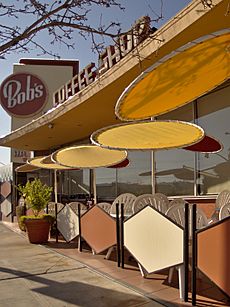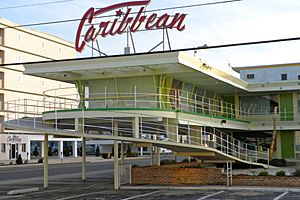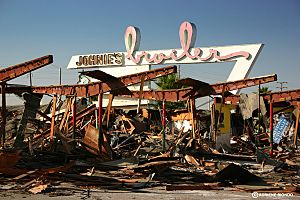Googie architecture facts for kids
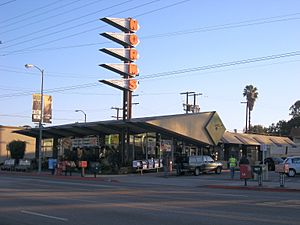
Googie architecture (pronounced GOO-ghee) is a super cool and futuristic style of building design. It was inspired by things like fast cars, jets, the exciting Space Age, and the Atomic Age. This unique style started in Southern California around the 1930s. It became really popular across the United States from about 1945 to the early 1970s.
Googie-style buildings were often used for motels, coffee houses, and gas stations. Later, it became known as part of the mid-century modern style. You can see its influence in famous buildings like Eero Saarinen's TWA Terminal. The name Googie came from a coffee shop in Hollywood called Googies Coffee Shop, designed by John Lautner. Other names for similar styles are Populuxe or Doo Wop.
Googie buildings often have cool features like roofs that sweep upwards, curvy and geometric shapes, and lots of glass, steel, and neon lights. They also used Space Age designs that showed movement. Think of boomerangs, flying saucers, atoms, and parabolas. There were also free-form designs, like "soft" parallelograms and shapes that looked like an artist's palette. These designs showed how excited American society was about space and the future. Like the Art Deco style before it, Googie became less popular over time. Many Googie buildings have been torn down. But some have been saved, like the oldest McDonald's restaurant in Downey, California.
Contents
What is Googie Architecture?
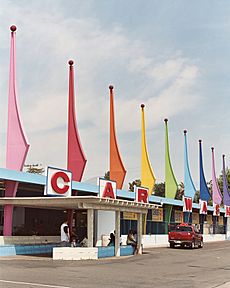
Googie architecture is a fun, eye-catching style that was popular after World War II. It was all about looking forward to the future. Imagine buildings that look like they're ready for takeoff or have parts that seem to float! This style was designed to grab your attention, especially when you were driving by in a car.
How Did Googie Get Its Name?
The name "Googie" started in 1949. That's when architect John Lautner designed the Googies Coffee Shop in Hollywood. This coffee shop had very special and noticeable features. The name "Googie" was actually a family nickname for Lillian K. Burton, whose husband, Mortimer C. Burton, owned the restaurant.
The original Googies Coffee Shop was on Sunset Boulevard in Los Angeles. Sadly, it was torn down in 1989. The name "Googie" became popular for the whole architectural style thanks to Douglas Haskell, an editor for House and Home magazine. One day, he was driving with photographer Julius Shulman and saw Googies. Haskell stopped the car and said, "This is Googie architecture!" He then wrote an article in 1952 that made the name famous.
Even though Haskell coined the term, he didn't actually love the Googie style. He used a fictional professor in his article to make fun of Googie. He felt it was too flashy and connected to Hollywood's style.
The History of Googie Style
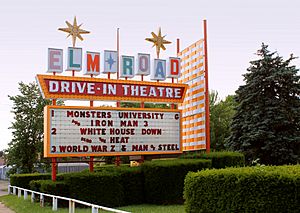
Googie architecture grew out of an earlier style called Streamline Moderne from the 1930s. Alan Hess, a writer who knows a lot about Googie, explains that in the 1930s, more and more people in Los Angeles had cars. This led to new businesses that served drivers. As cars became popular, cities started to spread out. Businesses could now open in the suburbs, not just in busy downtown areas.
These new suburban stores needed to be easily recognized from the road. So, owners and architects created bold, visual designs. This new way of designing buildings for customers on the go was all about communication.
Small drive-in restaurants in the suburbs were like giant billboards. They used big signs, bright neon lights, and round buildings to attract drivers. Hess says that because of more factories and travel in the 1930s, Streamline Moderne became popular. Its sleek designs showed speed and energy. These buildings had rounded edges, tall towers, and neon lights. They symbolized the fast pace of cars, trains, and even zeppelins.
Like Googie, Streamline Moderne looked futuristic. It signaled a new era of cars and technology. Drive-in places like diners, movie theaters, and gas stations were built to serve this new car-focused American city. These drive-ins were designed for cars, with round shapes and parking lots all around them. This made it easy for customers to get service from their vehicles. These ideas set the stage for Googie in the 1950s. During World War II in the 1940s, building slowed down because people had to save resources.
After the war, in the 1950s, the United States became very rich. American designers celebrated this wealth with hopeful and exciting designs. People were fascinated by nuclear power and the idea of spaceflight. Googie architecture used this excitement in its designs. It added energy with elements like the boomerang, diagonal lines, atomic bursts, and bright colors. Hess explains that buildings were designed to match what people wanted. Since the public loved rocket ships and nuclear energy, architects used these ideas in their work. Buildings had always tried to catch the eye of drivers, but in the 1950s, this style became very widespread.
It's hard to say who was the very first architect to use the Googie style. But Wayne McAllister was an early and important architect. He designed the 1949 Bob's Big Boy restaurant in Burbank. McAllister started by designing trendy restaurants in Southern California. This led to many Streamline Moderne drive-ins in the 1930s. He didn't have formal architecture training, but he was so skilled that he was offered a scholarship. McAllister created a special look for each coffee shop chain. This helped customers easily recognize a store from the road.
Besides McAllister, other important Googie architects included John Lautner, Douglas Honnold, and the team of Louis Armet and Eldon Davis from the Armet & Davis firm. Helen Liu Fong, a designer at Armet and Davis, was also key. She joined the firm in 1951 and designed Googie interiors for places like Johnie's Coffee Shop on Wilshire Boulevard, the first Norms Restaurant, and the Holiday Bowl.
America's interest in space travel greatly influenced Googie architecture. In the 1950s, space travel became a real possibility. In 1957, the Soviet Union launched Sputnik I, the first human-made satellite to orbit Earth. Then, in 1961, the Soviet Union launched Vostok 1 with Yuri Gagarin, the first human in space. The US leaders, Eisenhower and Kennedy, made competing with the Soviets in space a top national goal. This started the "Space Race".
Googie-style signs often have sharp, bold angles. These were meant to look like the sleek, fast shapes of a rocket ship. At the time, this unique architecture was a way to show excitement about new technology, like space rockets.
Key Features of Googie Buildings

Googie architecture often used structures that seemed to hang in the air (called Cantilevers), sharp angles, glowing plastic panels, and free-form shapes like boomerangs or artist's palettes. Some buildings even had tailfins, like cars! Some traditional architects didn't like Googie, thinking it was too flashy. But later, during the post-Modern period, it gained defenders. Here are some common features that make Googie stand out:
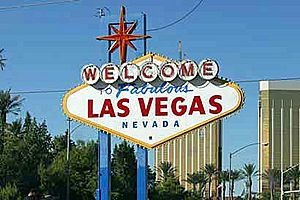
- Roofs that slope upwards: This is a very special part of Googie design. Many Googie coffee shops and other buildings have a roof that looks like two-thirds of an upside-down triangle. A great example is the famous, but now closed, Johnie's Coffee Shop on Wilshire Boulevard in Los Angeles.
- Starbursts: Starbursts are decorations common in Googie style. They show its Space Age and fun influences. Perhaps the most famous starburst is on the "Welcome to Fabulous Las Vegas" sign. This design looks like a "high-energy explosion," as Alan Hess describes it. It's a design element that doesn't have a practical use, but it looks cool and futuristic.
The boomerang shape was another design that showed movement. It was used as a support pillar or as a stylish arrow. Hess says the boomerang looked like a field of energy pointing in a direction.
Douglas Haskell, the editor who named Googie, said that if a Googie building looked like a bird, it had to be a "geometric bird." He also noted that Googie buildings should seem to defy gravity, looking like they "hang from the sky." Haskell's third rule for Googie was that it should have more than one theme or structural system. Because Googie buildings needed to be noticed by cars driving fast, they were never subtle.
One of the most famous Googie buildings is the Theme Building at Los Angeles International Airport (LAX). It was designed by James Langenheim of William Pereira and Charles Luckman and built in 1961.
One Googie drive-in restaurant that still exists is Harvey's Broiler (Paul Clayton, 1958), later called Johnie's Broiler in Downey, California. Part of it was torn down in 2006. But thanks to local people and preservation groups, it was rebuilt and reopened in 2009 as a Bob's Big Boy restaurant.
Another Googie example still in use is the main terminal at Washington Dulles International Airport. It was designed by Eero Saarinen in 1958. This terminal shows off the dramatic roof slope, big windows, and lots of concrete, similar to Saarinen's TWA Flight Center.
Where Can You Find Googie Buildings?
You can find classic Googie-style buildings in places like Miami Beach, Florida. Here, many commercial buildings took on the resort style of designers like Morris Lapidus. You can also see Googie in early Las Vegas, Nevada, and of course, in its birthplace, Southern California.
Wildwood, New Jersey
Wildwood, New Jersey, a beach town, has many motels with colorful designs. These are sometimes called "Vroom" or "Pu-Pu Platter" styles. This area is known as the Wildwoods Shore Resort Historic District.
The term "doo-wop" was used in the early 1990s to describe Wildwood's unique, space-age architecture. Many of Wildwood's Doo-Wop motels were built by Lou Morey. His Ebb Tide Motel, built in 1957 and torn down in 2003, is thought to be the first Doo-Wop motel in Wildwood Crest.
Googie Today
After the 1960s, Googie started to go out of style. This was after the Apollo 11 Moon landing, when the excitement about the Space Race and the Atomic Age lessened. Also, new movements against nuclear power began. Architects usually didn't think Googie was serious enough for academic praise. So, the architecture of the 1970s, especially the International Style, moved away from Googie. As Alan Hess points out, commercial buildings in the 1970s were meant to blend in, not stand out. By the mid-1960s, the newness of Googie was fading, and people started to dislike its flashy style. Since Googie buildings were often for service businesses, many developers didn't think they were important enough to save.
However, Alan Hess's book Googie in 1986 brought new appreciation for the style. Even though Googie started simply, Hess writes that "Googie architecture is an important part of the history of suburbia." Googie was a symbol of the early days of car culture.
One of the first groups to save Googie buildings was the Los Angeles Conservancy Modern Committee. It started in 1984 after Ship's coffee shop and Tiny Naylor's Drive-In were torn down in Hollywood. Despite losing some famous Googie spots, other coffee shops like Norms Restaurants, Johnie's Coffee Shop, and the Wich Stand have been recognized as historic places. The world's oldest McDonald's in Downey and the oldest remaining Bob's Big Boy in Burbank have also been saved and restored.
In Wildwood, New Jersey, a "Doo Wop Preservation League" works to save historic buildings. They work with businesses, city planners, and the state's historic preservation office. Wildwood's high-rise hotel area was the first in the US to have "Doo Wop" design rules for new buildings.
The architect Michael Hsu has designed many restaurants for P. Terry's in Austin, Texas, using the Googie style. Each location is unique, with slanted shapes, bright colors, and large, geometric roofs.
How Googie Influenced Other Things
Googie architecture grew from the futuristic Streamline Moderne style. It took those ideas and updated them for the 1950s. While 1930s architecture was quite simple, Googie loved being fancy. Hess says this is because the idea of the future from the 1930s felt old by 1950. So, architecture changed with it. In the 1930s, streamlined trains and cars were advanced. Streamline Moderne buildings looked like their smooth, simple, aerodynamic outsides. That simplicity might have shown the Depression era's need to save money.
The eye-catching Googie style was perfect for busy, multi-lane highways. It was popular in motel architecture and especially in commercial signage. Googie's influence was clear in Los Angeles and Las Vegas from about 1945 to 1970. Many of the same architects who designed Googie coffee shops in Los Angeles also designed famous hotels and casinos in Las Vegas. Private clients were the main supporters of Googie. Eventually, the style went out of fashion. Over time, many Googie buildings have either fallen apart or been completely destroyed.
The over-the-top, once-futuristic Googie style was seen in cartoons like The Jetsons and the original Disneyland (which had a Googie-inspired Tomorrowland). Decades later, this style led to something called retrofuturism. Googie also inspired the background art in animated TV shows and movies like Dexter's Laboratory, Johnny Bravo, The Powerpuff Girls, Futurama, George Shrinks, The Adventures of Jimmy Neutron: Boy Genius, My Life as a Teenage Robot, and The Incredibles.
|
See also
 In Spanish: Googie para niños
In Spanish: Googie para niños


